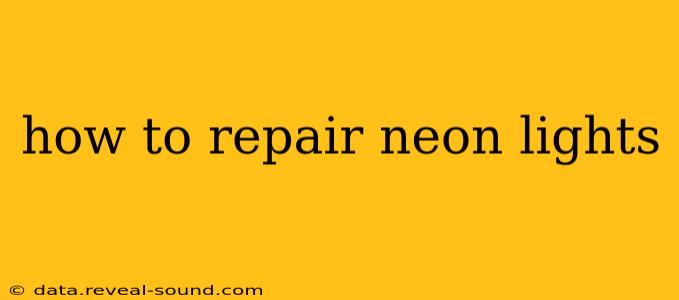Neon lights, with their vibrant glow, add a unique aesthetic to any space. However, these iconic signs aren't indestructible. Knowing how to repair them can save you money and keep your neon masterpieces shining brightly. This guide will walk you through the common issues and repair methods, equipping you with the knowledge to tackle minor repairs yourself. Disclaimer: Working with high-voltage electricity is dangerous. If you're uncomfortable working with electricity, it's best to consult a professional neon sign repair technician.
What Causes Neon Lights to Fail?
Before diving into repairs, let's understand why neon lights malfunction. Several factors can contribute to neon light failure:
- Gas Leaks: Over time, the glass tubing can develop tiny cracks, leading to gas leakage and a dimming or complete loss of light.
- Electrode Failure: The electrodes, which conduct electricity into the neon gas, can wear out or become damaged, preventing the gas from ionizing and emitting light.
- Transformer Issues: The transformer, which steps up the voltage, is crucial. A malfunctioning transformer won't supply the necessary high voltage, resulting in a non-functional sign.
- Wiring Problems: Loose connections or damaged wiring can interrupt the electrical flow, causing the light to flicker or fail completely.
- External Damage: Physical damage, such as impacts or harsh weather conditions, can crack the glass tubing or damage the wiring.
How to Identify the Problem in Your Neon Light
Troubleshooting is the first step. Here's a methodical approach:
- Visual Inspection: Carefully examine the entire neon sign for any visible damage, cracks in the glass tubing, or loose wiring.
- Check the Transformer: Ensure the transformer is functioning correctly. Listen for unusual buzzing sounds or overheating. A multimeter can help verify the output voltage.
- Inspect the Electrodes: Look closely at the electrodes at each end of the tube. Are they damaged or discolored? Burnt electrodes are a common cause of failure.
- Test the Wiring: Trace the wiring from the transformer to the electrodes, checking for any loose connections, breaks, or signs of damage.
Troubleshooting Common Neon Light Problems:
H2: My Neon Light is Dim or Flickering:
This is often a sign of a gas leak, a failing transformer, or a problem with the electrodes. Start with a visual inspection to check for cracks or damaged components. If you find no visible damage, the transformer or electrodes might be the culprit.
H2: My Neon Light is Completely Off:
This is more serious, pointing to a complete break in the electrical circuit or a major component failure. Check the transformer first, then the wiring and electrodes. A gas leak is also possible but may be harder to identify without specialized equipment.
H2: I See a Dark Spot in My Neon Light:
A dark spot usually indicates a section of the tube where the gas has leaked or the coating has failed. Unfortunately, repairing this often requires specialized glassblowing skills.
H2: How Do I Fix a Cracked Neon Tube?
Fixing a cracked neon tube is generally not feasible for DIY repairs. The repair requires specialized glassblowing equipment and techniques to create a vacuum, refill the tube with neon gas, and reseal the crack. It is best to contact a professional neon sign repair technician for this type of damage.
H2: Can I Replace the Transformer Myself?
Replacing a transformer is possible if you have some electrical experience and can identify the correct voltage and amperage rating. Ensure the power is OFF before attempting any work. However, if you're not comfortable working with electricity, it’s best to consult a professional.
H2: How Often Should I Inspect My Neon Lights?
Regular inspections, at least once or twice a year, can help identify minor issues before they become major problems. Early detection can prevent extensive and costly repairs.
Conclusion:
Repairing neon lights can be challenging, particularly if you lack experience working with high-voltage electricity and specialized equipment. While minor repairs, such as tightening loose wiring, might be manageable for DIY enthusiasts, significant problems often necessitate professional assistance. Remember safety first – always turn off the power before working on any electrical components. Understanding the potential causes of neon light failures and how to troubleshoot them will allow you to make informed decisions about repair or professional help.
